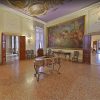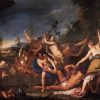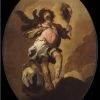In this room there are three Baroque paintings of imposing size. They are so big they practically cover the whole of the walls. Antonio Molinari is the author of the work on the wall in front of you, The Battle between Centaurs and Lapiths. The painting Hercules and Omphalus to the right of the entrance door is by Antonio Bellucci, while Orpheus Torn to Pieces by the Bacchantes on the left is by Gregorio Lazzarini.
These are three complex, elaborate narrative scenes painted by the major ‘experts’ of this field of Venetian art; they were already considered by their contemporaries to be the most famous painters working in Venice. The works thus show late 17th-century Venetian painting at its best, and although the names of their authors are now familiar only to specialists, in their time they were internationally famous. The paintings were commissioned by the procurator Vettòre Correr, who intended to place them in the so-called ‘Camaròn’, the main reception room of the palace. The themes as a whole illustrated the soul of Man devastated by passions and excesses. They may have been intended as an original, ambiguous, invitation to temperance for those banqueting in that room, where the heroes of mythology showed their least heroic side.
The ceiling is made up of five ovals inside gilded frames which stand out from the dark blue background. Again, this series of ceiling paintings was not originally part of the original furnishings of Ca’ Rezzonico, but was transferred into the Museum in 1936 from Palazzo Nani on the Cannarégio canal, along with the series now in the Brustolòn room. Decoration of ceilings with canvases set into exuberant wooden frames was typical of the late 17th century and preceded the widespread popularity of the fresco in the following century. In the centre we see Prometheus with the mirror given to him by Minerva, and the eagle. This is surrounded by other scenes showing Daedalus and Icarus, Prometheus released by Hercules, Perseus showing Atlas the head of Medusa, and Andromeda bound to the rock. The five ovals are the work of the Vicenza painter Francesco Maffei and are an excellent example of his exuberant, unconventional style, so different from the more composed, formal one of the paintings on the walls by his younger colleagues.
In the centre of the room stands a splendid writing-desk veneered in precious woods, with carved ivory inlays and gilded bronze rods. This is the work of the famous Turin cabinet-maker Pietro Piffetti, signed and dated 1741.


